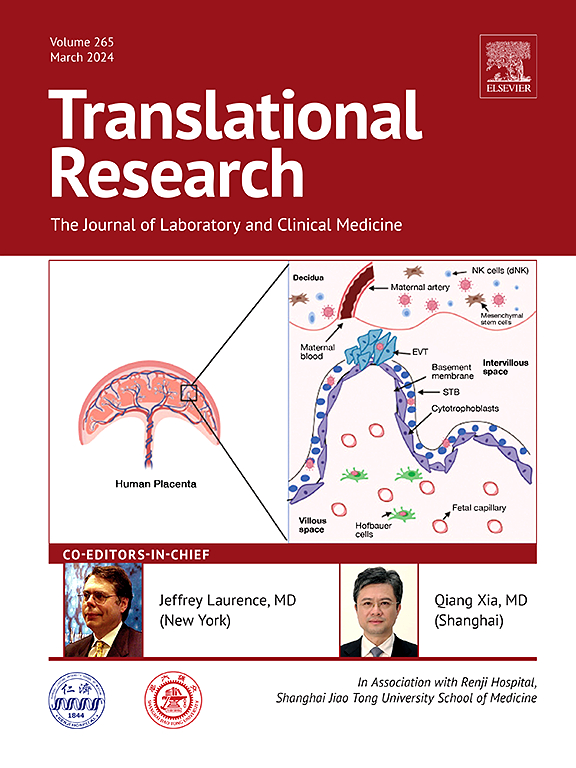阻断 TREM2 可通过调节鞘脂代谢改善肺部炎症和纤维化。
IF 5.9
2区 医学
Q1 MEDICAL LABORATORY TECHNOLOGY
引用次数: 0
摘要
肺纤维化是一种涉及全身炎症和胶原异常沉积的慢性间质性肺病。脂质代谢失调,如巨噬细胞依赖性脂质分解,已被认为是肺纤维化发展的关键因素。然而,人们对其中涉及的信号通路和关键调节因子知之甚少。在这里,我们发现髓系细胞上表达的触发受体2(TREM2)在调节肺巨噬细胞的脂质处理能力和诱发肺纤维化方面起着关键作用。通过整合分析肺纤维化患者和小鼠的单细胞和大体积 RNA 测序数据,我们发现肺巨噬细胞由具有不同促纤维化特性的异质群体组成,并发现纤维化肺中的鞘脂代谢和趋化相关基因的表达均升高。TREM2是一种识别多种脂质的传感器,在单核细胞衍生巨噬细胞的一个亚群中特异性上调。通过常规/条件性基因敲除或服用可溶性TREM2阻断TREM2可减轻博莱霉素诱导的肺纤维化。通过利用 scRNA Seq 和脂质组学,我们发现 Trem2 缺乏会下调各种鞘磷脂的合成,并抑制 Ccl2 等趋化因子的表达。综上所述,我们的研究结果不仅揭示了肺纤维化过程中脂质组谱和肺巨噬细胞图谱的改变,还表明靶向影响肺鞘磷脂代谢和趋化因子分泌的关键调节因子TREM2可在未来造福肺纤维化患者。本文章由计算机程序翻译,如有差异,请以英文原文为准。
Blockade of TREM2 ameliorates pulmonary inflammation and fibrosis by modulating sphingolipid metabolism
Pulmonary fibrosis is a chronic interstitial lung disease involving systemic inflammation and abnormal collagen deposition. Dysregulations in lipid metabolism, such as macrophage-dependent lipid catabolism, have been recognized as critical factors for the development of pulmonary fibrosis. However, little is known about the signaling pathways involved and the key regulators. Here we found that triggering receptor expressed on myeloid cells 2 (TREM2) plays a pivotal role in regulating the lipid handling capacities of pulmonary macrophages and triggering fibrosis. By integrating analysis of single-cell and bulk RNA sequencing data from patients and mice with pulmonary fibrosis, we revealed that pulmonary macrophages consist of heterogeneous populations with distinct pro-fibrotic properties, and found that both sphingolipid metabolism and the expression of chemotaxis-related genes are elevated in fibrotic lungs. TREM2, a sensor recognizing multiple lipid species, is specifically upregulated in a subset of monocyte-derived macrophages. Blockade of TREM2 by conventional/conditional knock-out or soluble TREM2 administration can attenuate bleomycin-induced pulmonary fibrosis. By utilizing scRNA Seq and lipidomics, we found that Trem2 deficiency downregulates the synthesis of various sphingomyelins, and inhibits the expression of chemokines such as Ccl2. Together, our findings not only reveal the alterations in lipidomic profiles and the atlas of pulmonary macrophages during pulmonary fibrosis, but also suggest that targeting TREM2, the crucial regulator affecting both pulmonary sphingolipid metabolism and the chemokines secretion, can benefit pulmonary fibrosis patients in the future.
求助全文
通过发布文献求助,成功后即可免费获取论文全文。
去求助
来源期刊

Translational Research
医学-医学:内科
CiteScore
15.70
自引率
0.00%
发文量
195
审稿时长
14 days
期刊介绍:
Translational Research (formerly The Journal of Laboratory and Clinical Medicine) delivers original investigations in the broad fields of laboratory, clinical, and public health research. Published monthly since 1915, it keeps readers up-to-date on significant biomedical research from all subspecialties of medicine.
 求助内容:
求助内容: 应助结果提醒方式:
应助结果提醒方式:


